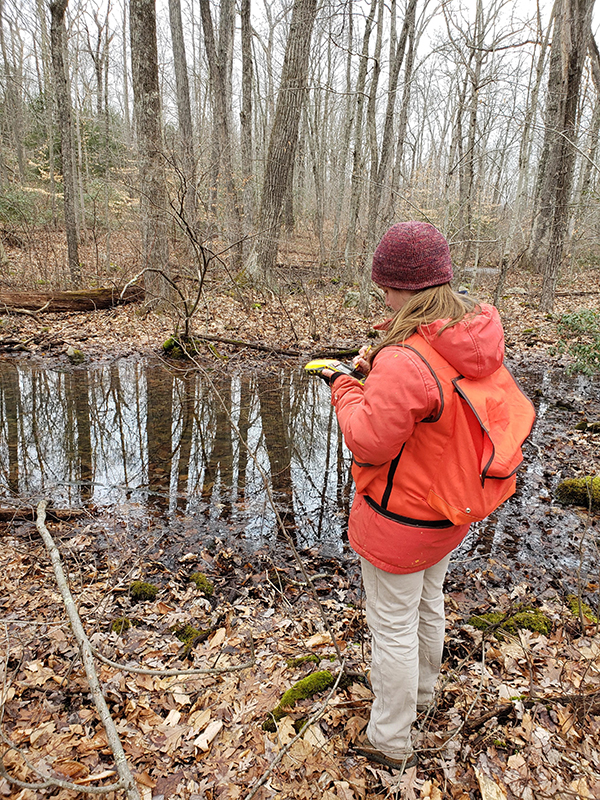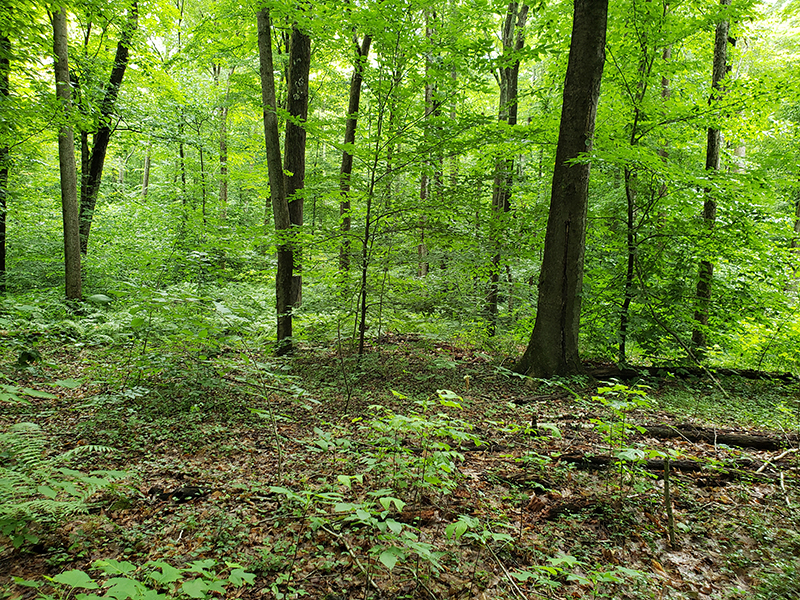Why Manage Forests in the Face of Climate Change
What Is Forest Management?
Forest management is the application of scientific and technical principles by a certified forester in order to meet specific goals. It takes many forms, but usually involves periodic treatments or practices which are done to change forest conditions. Forest management uses a variety of practices, such as brush control and timber harvesting, to provide a balance of important societal and ecological benefits.

Jill Humphreys, a State Lands Forester for CT DEEP Forestry, is assessing and mapping a vernal pool she found when inventorying a woodlot. Vernal pools are are important features in wooded landscapes, and as such, foresters take caution to leave an unharvested buffer around them. Photo Credit: Jerry Milne, CT DEEP Forestry
Climate change poses a substantial risk to Connecticut’s forests, but these forests can also be a part of the solution. Forest management practices can be tailored to improve forest health, resilience, and adaptability, and they also create opportunities to increase forests’ capacity to mitigate the negative impacts of climate change on society. Healthy forests are better able to withstand the difficult conditions associated with climate change, and resilience is their capacity to maintain ecological function in the presence of disturbance. Some disturbances will cause systematic changes in forests, so it is also important that they be adaptable.
Managing forests to increase their health, resilience, and adaptability should take place on two separate scales: small scale or stand level, and large scale or landscape level.
Small scale management activity focuses on manipulating individual groups or stands of trees within a larger forest block so that the trees in that particular component of the forest are able to function at their highest capacity. This typically involves practices like thinning dense stands to allocate growing space to the best trees, controlling brush and undesirable understory growth to increase complexity at or near the forest floor, and creating canopy gaps of various sizes to increase vertical structure. Large scale management activity involves making informed decisions about where to manage existing trees and stands, where to establish and grow new trees, and where to create reserves or other passive management areas. This process can be implemented at scale on large properties, but forest ownership in Connecticut is such that it must take place across many different properties and ownership types. Together, these practices diversify conditions across the landscape and promote regional forest health, resilience, and adaptability.

Seven years following an un-even aged selection harvest, and this stand now has well established young and advanced tree regeneration within the understory of healthy over story trees. This is an example of how management can promote resiliency. Photo Credit: Jerry Milne, CT DEEP Forestry
Managing forests to increase their health, resilience, and adaptability also requires thinking beyond the trees and plant life, considering factors like wildlife, recreation, invasive pests and pathogens, and additional stressors from climate change. Foresters are well trained at incorporating these factors into management activities and regularly take thoughtful, preventive action to ensure long-term forest health. Common examples include creating patches of young forest within an area that is dominated by mature forest, which serves the dual role of adding valuable wildlife habitat where it would otherwise not exist and decreasing vulnerability to landscape-level wind events.
Forest management also facilitates the creation of wood products, which play an important role in mitigating the negative impacts of climate change on society. The forest products industry provides sustainable livelihoods for people whose futures are inextricably tied to the persistence of a healthy forest resource in the state. This acts as a disincentive to forest conversion and unsustainable logging. The revenue from forest product sales is important to ensure landowners have the means to keep forests as forests.
Durable wood products, which have long lifespans, store carbon. Harvesting them from the forest serves to diversify the carbon storage pools, while also facilitating additional sequestration from the trees left in the forest and allowing new trees to grow. In fact, for every one cubic foot of wood removed from Connecticut forests, six cubic feet grow. Non-durable wood products like paper and firewood do not store carbon in the long-term, but they still play an important role in the fight against climate change by the substitution effect. Heating with high-efficiency wood combustion systems, for example, provides an alternative to fossil fuel heating and has a much smaller environmental footprint. This is also important on a global scale, as Connecticut exports many of its wood and forest products - though this practice does involve transportation related carbon emissions, in many cases these products replace others which are sourced from unregulated systems with potential for harmful environmental and societal impacts. When Connecticut Grown Forest Products are used in-state, however, they substitute for imports, which decreases transportation related costs, emissions, and the removal of material from unregulated systems elsewhere.
Learn more about the portfolio of options for managing for forest heath.

Did you know? Connecticut is the only state in the eastern U.S. that cuts and treats rail ties in the same facility? There are 3,250 wooden cross ties per mile of railroad? Imagine the carbon footprint that would be associated with this form of mass transit if all these ties were made of concrete? Photo credit: Jerry Milne, CT Forestry
Back to Climate Change and Connecticut Forests for more information
Content last updated April 2022.

